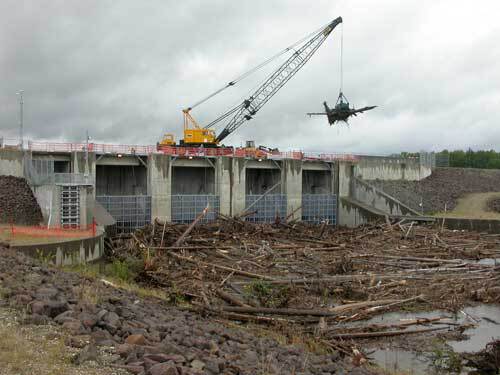

Mortgage is paid on flood control project
It is gray and raining and chilly and I want some coffee. I’m driving south from Fairbanks, wondering when I have seen a wetter few weeks in Interior Alaska. No past episode is coming to mind.
I’m probably forgetting a time or two, but I know a few things: the town of Nenana has water in its streets, four-wheelers are floating upside-down in Salcha, and the islands and gravel bars have disappeared on the big river (Tanana) and the smaller river (Chena).
The gray and silty Tanana River, fed by melting glaciers, rainfall, and snowmelt all the way to the Canada border, is as wild as the day the earth tilted enough for it to start flowing. But the Chena River has a manmade throttle built after the great flood of 1967, when the Chena oozed over its banks and turned Fairbanks into a lake. I want to see this device at work.
I’m off to the Chena River Lakes Flood Control Project. In the 1970s, the U.S. Army Corps of Engineers moved mountains of damp earth and left behind orderly channels. After pouring as much concrete as exists in a California highway cloverleaf, engineers directed the Chena River through four slots the size of garages. During times of extremely high water—usually spring, when snow melts from the soft slopes that drain into the upper Chena; and late summer, when a shift in the jet stream channels rain northeastward through a conduit made by the Kuskokwim Mountains and Alaska Range—dam-tenders at the flood control project lower 30-ton metal gates like four garage doors into the surface of the Chena. They skim water from the top, and, for a while, divert some of it from its path to Alaska’s second-largest city, 40 looping river miles downstream.
John Schaake is always here when the floodgates touch the Chena. He’s the manager of the Chena River Lakes Flood Control Project.
“We had the gates down from 3:30 a.m. Friday to Saturday at 5:16 a.m.,” Schaake says as he drives me along the top of the eight-mile rock-filled dam, 50 feet above a floodplain that can hold 224,000 football fields of one-foot deep water, should the need arise. There was a need in early summer 1992, when snowmelt pushed back from the floodgates reached the Tanana River via the channel.
To our right, in that broad floodplain, are now shallow lakes, the shunted river water from two nights ago that would have wet low-lying areas in Fairbanks. Families of ducks float on the new pools, which also feature green willows sticking up like cattails.
Our next stop is the concrete “control works” of the dam, where four steel gates have pushed against the Chena 20 times in the last 27 years. The gates close when the Chena swells to a certain level.
The floodgates are open now, but hundreds of spruce logs have jammed against steel screens in front of the four concrete river channels. The floating cordage is staggering, one would guess enough to heat a large home for a century or so. A crane picks at the pile with a clamshell grabber, biting fistfuls of spruce logs and dropping them into dump trucks.
“It’ll take seven days of working 12 hours to get that out of there,” Schaake says.
In the week to come, it may stop raining, the crane will probably finish clearing the flotsam, and the floodgates will remain suspended above the river, at least until next spring, or maybe for several more years.
As we watch the river flow clear and clean downstream of the dam, Schaake says the Chena River Lakes Flood Control Project is one of those large human undertakings that was worth the millions.
“We burned the mortgage on this place with all the flood damage it’s prevented,” he says, “and every little flood adds value to it.”






